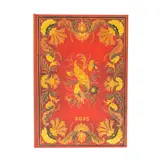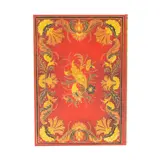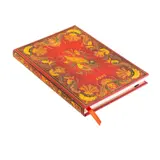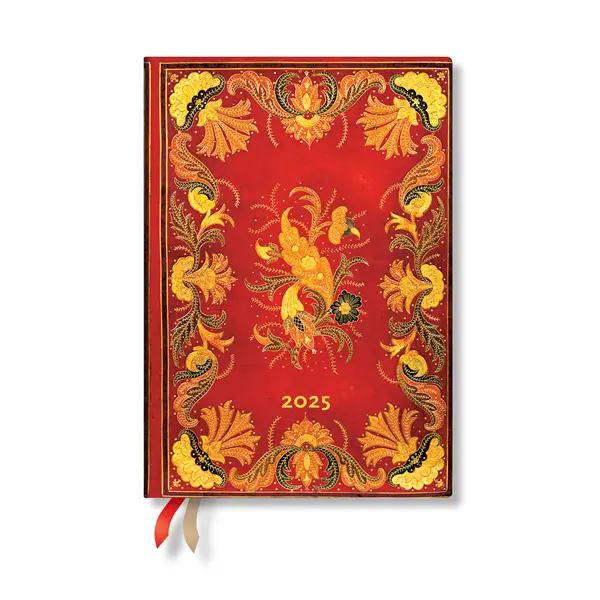Agenda 2025 Fiammetta
Fiammetta
This Baroque-inspired design comes from a 1725 binding of The Decameron of Giovanni Boccaccio. Boccaccio, an Italian writer and poet, helped lay the foundations of Renaissance humanism. With its scope from humour to tragedy and its vivid narrative structure, The Decameron remains an affirmation of humanity and moral values.

Numéro GTIN: 9781408760147
Article №: DHD6014
Détails du produit
| Format | Midi |
| Taille | Largeur: 125 mm Hauteur: 180 mm Profondeur: 18 mm |
| Intérieur | Horizontal |
| Nombre de pages | 160 |
| Fermeture | Reliure Cousue Smyth |
| Couleur | Violet |
| Type d'armure | Fermeture Élastique |
| Type de poche intérieure | Pochette Mémos |
| Papier intérieur | Lisse |
| Bandeau de lecture | 2 |
| Agenda Période | Janvier 2025 - Décembre 2025 |
| Agenda Année | 2025 |
| Agenda Mois | 12 |
| Couleur du papier | Crème |
| Matériau | Couvertures cartonnées 100% recyclées |
| Durable | Oui |
| Langue | Allemand |
| Coupe couleur | Non |
| Poids du papier | 100 g/m² |
Autres caractéristiques
- Couvertures cartonnées 100% recyclées
- Papier décoratif imprimé
- Papier certifié FSC
- Coutures filetées et de colle le cas échéant
- Papier issu d’exploitations forestières durables
- Planning mensuel
- Tableaux de conversion
- Planning annuel
- Mini calendriers
- Indicatifs téléphoniques internationaux
- Vacances internation
- Fuseaux Horaires
- Pages de notes
- Carnet d’adresse amovible
- Plaque signalétique
Modèle original:
Binding for an edition of The Decameron of Giovanni Boccaccio
Période:
1725 binding (14th-century story) Région:
French binding (Italian story) Description
Ignite your creativity with fiery Fiammetta. This sensuous Baroque-inspired cover comes from a 1725 binding of The Decameron of Giovanni Boccaccio, a masterpiece of Italian literature dealing in stories of love and lust.Giovanni Boccaccio (1313–1375) was an Italian writer and poet who, alongside Petrarch, laid the foundations of Renaissance humanism. He wrote in the Tuscan vernacular, raising this common Italian language to the level of the Latin classics and making works like The Decameron accessible to the average reader.Though he maintained relationships with important figures such as Petrarch, it was Boccaccio’s connection to the everyday people (the popolo minute) that would greatly influence much of his writing. In 1348 the city of Florence was ravaged by the Black Death, which killed nearly three-quarters of the city’s population, primarily the working class. Though it is uncertain if Boccaccio himself was in Florence at this time, it is known that his stepmother died during the epidemic and his father worked on the government’s efforts to assist its citizens.Boccaccio began writing The Decameron, his defining work, around 1349. Romantic in tone and form, the work broke with medieval standards by focusing on human emotions and ambitions, especially the ability to overcome (and even exploit) fortune. His sense of humanism was starkly in contrast to the period’s prevailing stories of fate and fortune, and to the Middle Ages’ values of courage, faith and transcendence.The book contains a collection of novellas structured as a frame story. It consists of 100 different tales told by the 10 main characters, who find themselves sheltering in a secluded villa just outside Florence to escape the ravaging illness. There are tales of wit and practical jokes, lustful romantic entanglements and tragic, real-life consequences. While it is generally acknowledged that the framework of many of these stories was borrowed from myth and folklore, it is Boccaccio’s sophisticated writing style that makes this a unique and defining work all his own. With its scope from humorous to tragic and prevailing sense of humanism in a vivid narrative structure, The Decameron remains an affirmation of humanity and moral values even when read today.This 18th-century binding of The Decameron is now held at the Musée Condé in Chantilly, France (along with the binding that inspired our Evangeline design). With golden flowers and arabesques bursting forth from a rich, red background, Fiammetta, named for one of the book’s main characters, is sure to spark your imagination and let your passions flow.





